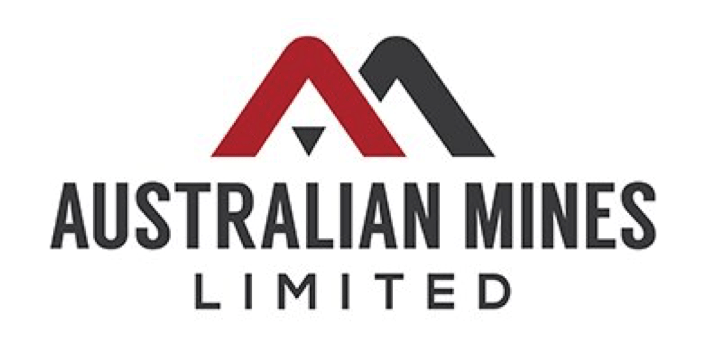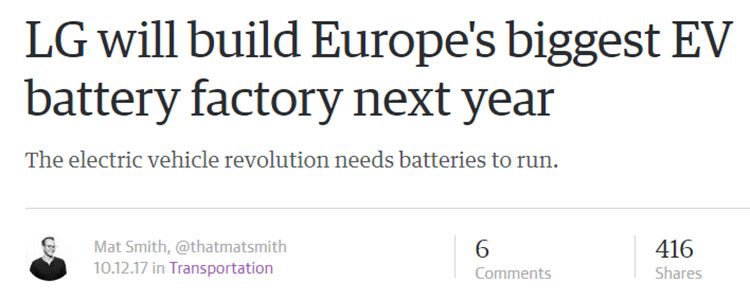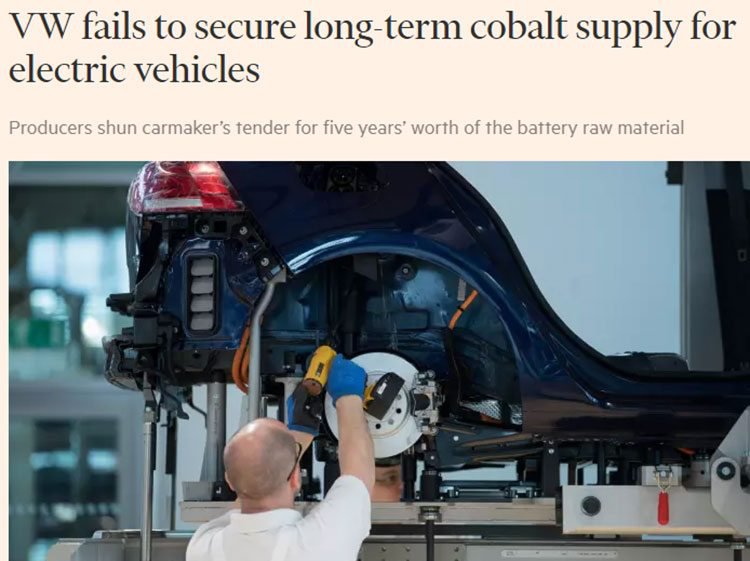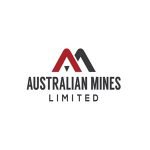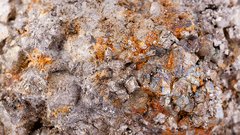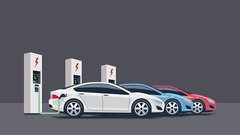AUZ: Unlocking Value in NSW Cobalt
Hey! Looks like you have stumbled on the section of our website where we have archived articles from our old business model.
In 2019 the original founding team returned to run Next Investors, we changed our business model to only write about stocks we carefully research and are invested in for the long term.
The below articles were written under our previous business model. We have kept these articles online here for your reference.
Our new mission is to build a high performing ASX micro cap investment portfolio and share our research, analysis and investment strategy with our readers.
Click Here to View Latest Articles
There’s no getting around it. We’re moving towards a greener, low-emissions future faster than you can say ‘Tesla-powered electric vehicle revolution’.
The global EV battery market is set to grow at a compound annual growth rate (CAGR) of 41.95% between 2017 and 2021. And according to Wall Street research film, Bernstein, EVs could represent 40% of all car sales in 20 years’ time .
Crucial to this increasingly pervasive shift will be access to an adequate, reliable supply of key battery metals, including cobalt and nickel.
One ASX developer that could be on its way to emerging as a major global supplier of raw materials to this burgeoning sector is Australian Mines (ASX:AUZ).
AUZ has taken early notice of this global movement towards renewable energy sources and battery technologies, and this emphasis shows in both its underlying strategy and portfolio.
AUZ has two world-class, JORC compliant cobalt, nickel and scandium projects in NSW and Queensland: Sconi and Flemington.
Each of these is estimated to have a mine life of at least 20 years, and have the potential to provide some 95% of the raw materials used in emerging battery technologies.
It’s no surprise, then, that AUZ has piqued significant interest from battery manufacturers, as well as other international companies that operate in the energy and automotive spaces.
In turn, this has placed AUZ directly on the radar of some of the world’s biggest investment houses.
Of course, AUZ remains a speculative stock and investors should consider professional financial advice if considering this stock for their portfolio.
AUZ’s recent placement to international institutional investors was oversubscribed by almost three times the initial amount sought — a crystal-clear endorsement of the high-calibre nature of its projects and nimble development strategy.
The funds raised to the tune of $20 million put AUZ in a very comfortable position to fast-track development of its assets, including completion of its Bankable Feasibility Study (BFS) at its Sconi Project in time for April next year.
In support of the BFS, AUZ is continuing trial mining, and is also constructing a demonstration-scale processing plant in Perth that will be capable of producing commercial-grade samples of cobalt sulphate, nickel sulphate and scandium oxide to progress its negotiations with potential off-take partners and financiers – discussions that are already well advanced.
At its Flemington Project, moreover, AUZ has plans to extend and increase the existing mineral endowment through a series of targeted drilling campaigns. A pre-feasibility study (PFS) for Flemington is also set for completion by mid-2018.
An important thing to bear in mind here is that Flemington is the direct western continuation of Clean TeQ’s (ASX: CLQ) Syerston ore body (recently renamed Sunrise), separated only by a tenement boundary.
This was recently confirmed by its Flemington maiden cobalt mineral Resource estimate, which has strong potential for amplification.
As a larger cobalt peer, moreover, CLQ itself also provides an intriguing comparison.
CLQ’s market cap is nearing $1 billion, and is currently circa $830 million.
AUZ is currently valued at $235 million – that’s around a quarter of the market cap of CLQ.
AUZ’s Sconi Project, which is the most advanced project of its kind in Australia, is very much comparable to Sunrise in terms of Resource, expected feed grade and processing efficiency. In fact, it has approvals in place and potential exploration upside that give it an edge over CLQ...
At the rate it’s going, AUZ could stand to critically disrupt the uneven supply/demand dynamics that underpin the cobalt market.
All in all, this ASX small-cap has had a big year, and there’s still more to come.
In the remaining weeks of 2017, AUZ’s first commercial battery-grade products are scheduled for shipment.
It also expects assay results back from its Resource expansion drill at Flemington this month... all of which translates into more waves of newsflow for this fast-moving company.
Without further ado, let’s check back in with:
AUZ’s market edge
Since we first introduced you to Australian Mines Limited (ASX:AUZ) in August , this ASX developer has rapidly emerged as a force to be reckoned with. At that point in time, this battery technology metals play was capped at a mere $29.9 million.
It’s worthwhile looking at the dizzyingly fast growth of AUZ over a matter of months, as it transitioned from exploration to development in steady strides. At the time of our October article, AUZ to Emerge as Major Developer of Key Battery Technology Metals , the company’s market cap had sprung to $49.8 million.
Today, AUZ sits at $234.7 million – that’s an increase of more than 500% since October.
The Next Mining Boom first covered AUZ back on August 30 th of this year – since then it has been a wild ride, with the stock up as high as 760% since, and the company securing $20 million from international investors:
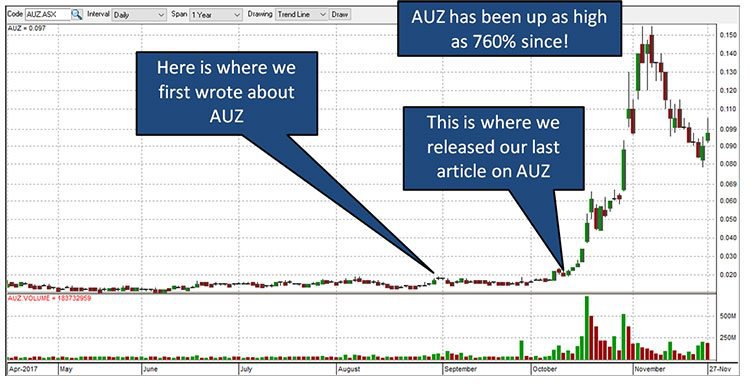
The past performance of this product is not and should not be taken as an indication of future performance. Caution should be exercised in assessing past performance. This product, like all other financial products, is subject to market forces and unpredictable events that may adversely affect future performance.
As became clear to us early on, AUZ is the kind of forward-focused story that ticks all the boxes.
Here’s how AUZ’s flagship Sconi Project is tracking compared to its cobalt peers:
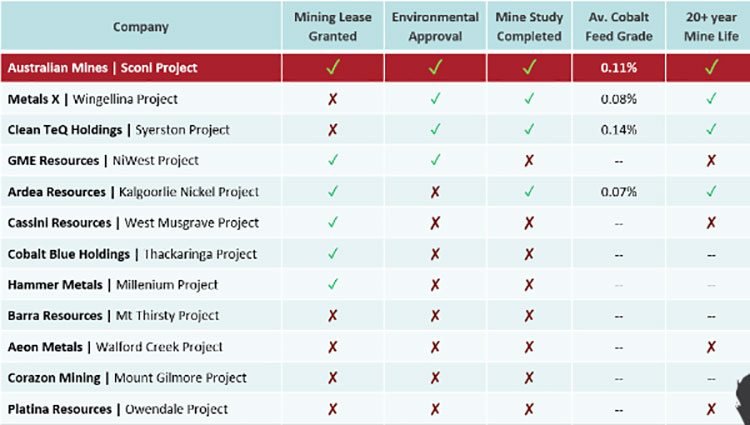
Source: Australian Mines
AUZ’s Sconi is the most advanced project of its kind in Australia, with mining and environmental approvals in place, and a BFS is well advanced.
All systems are go in terms of development, with trial mining done, plant design identified, and proposed water supply on site. Sconi is de-risked and on the road to a final investment decision, which is anticipated early near year.
There is no clear date, however, so investors should take a cautious approach to their investment decision and base it on all publicly available information.
Further to that, Sconi is situated within some 250 kilometres of the approval cobalt and nickel exporting port of Townsville in northern Queensland, and benefits from surrounding infrastructure including sealed roads, electricity, water, local housing, and a skilled local workforce. All of this bodes nicely, should AUZ manage to convert the resource into a commercial supply.
What also gives AUZ its considerable edge is that it’s a ‘full-package’ kind of play. This isn’t just a cobalt story – it’s all about the cobalt-nickel combination and scandium at work here.
Battery manufacturers need both of these materials.
And by negotiating an offtake agreement with a company like AUZ, they’ll be able to secure a reliable supply of both these critical metals from a single source. A one-stop shop, if you will.
A cobalt-only supplier, on the other hand, would only satisfy some 15% of a battery maker’s supply chain. And on top of that, AUZ’s expected average cobalt feed grade of 0.11% is higher than that quoted by most pure cobalt plays. This means that each tonne of ore extracted at Sconi contains more than that of AUZ’s peers.
As we alluded to earlier, AUZ’s point of difference – and potential upside – is sharpened further with a comparison to its larger peer, Clean Teq (ASX: CLQ).
As we’ve noted, AUZ’s Flemington Cobalt-Scandium-Nickel Project and CLQ’s Sunrise are two halves of the same deposit.
Sconi bears a range of similarities to Sunrise. Here’s a comparison:

Source: Australian Mines
Bearing all of that in mind, CLQ’s market cap is $830 million. In contrast, the market is valuing AUZ at $235 million, and it’s at an earlier stage in the game than CLQ.
$20 million from institutional investors to fast-track development
Something that’s further reinforcing AUZ’s strong potential as a future supplier of battery metals is the $20 million it’s secured in funds from institutional investors, as announced in early November.
Given the significant interest displayed in AUZ from institutional fund managers, the company approached a number of these funds for the purposes of acquiring an interest via the recently completed placement.
The response from these funds was very strong, with AUZ receiving applications for almost $40 million – more than three times the original amount AUZ were seeking.
After consultation between AUZ’s board and the incoming investors, the company accepted applications for $20 million.
Institutions that participated in this placement included a fund that’s arguably one of the world’s largest investment managers. A leading Asian-based resources investment company also used this opportunity to acquire a stake in AUZ.
These funds put AUZ in fighting financial shape, ensuring continued trial mining and sample production from Sconi, as well as finalisation of its demonstration plant construction, completion of the Sconi BFS, and accelerated Resource expansion drilling at Flemington.
What’s more, AUZ’s ability to attract the investment of these global funds is strong testimony to the quality of its projects and the sturdy arm of its management team.
Given the scale and advanced nature of its cobalt-nickel-scandium deposits, AUZ is clearly capable of attracting significant interest from battery makers, as well as other international companies that operate in the energy and automotive spaces.
Which brings us to...
The EV-powered future: or, a question of supply and demand
Cobalt prices have surged over the last year, driven by building demand from battery and electric vehicle (EV) manufacturers. In fact, global demand for cobalt and nickel – two of the essential ingredients in the EV batteries – has never been higher.
The entire automobile manufacturing industry is transitioning to electric cars over the coming years, and planning battery gigafactories to go along with them. Alongside those changes, governments are also seeking to incorporate renewables into their future energy mixes.
Over the next two decades, this global fleet of electric cars could reach 282 million – that’s some 16% of all cars on the road, according to Bloomberg New Energy analysts .
Volvo has said that every car it launches from 2019 will be at least partly electric.
By 2022, Renault, Nissan and Mitsubishi also collaboratively plan to have twelve EVs.
This month, Ford, BMW, Daimler and the VW Group (with subsidiaries Audi and Porsche) have joined forces to open 400 charging stations for EVs across Europe by 2020, with the first 20 locations to be up and running by the end of this year.
On top of that, Tesla is ramping up its Nevada battery gigafactory from 35 GwH to 150, and LG plans to open Europe’s largest EV battery factory in Poland next year.
So this global shift is a clear inevitability. But here’s the rub.
All of these mammoth EV efforts will require more cobalt than the world can actually currently supply.
That’s the reason why Volkswagen is trying to secure at least five years’ supply of cobalt – and apparently failing, as the Financial Times article below explains.
While demand for cobalt in EV batteries alone is expected to grow four-fold by 2020 and eleven-fold by 2025 , supply is another matter. This supply gap is expected to reach 12,000 tonnes by 2021 .
60% of the world’s cobalt comes from the conflict-riddled Democratic Republic of Congo (DRC). Much concern has been raised about how cobalt is mined, and this is a major obstacle in securing a stable supply.
So it seems like AUZ, whose Sconi Project can produce the raw materials required in a Tesla Model S battery pack cathode (which is comprised of 80% nickel and 15% cobalt), could be at precisely the right place, at the right time.
Although, it still has a lot of work to do and investors should seek professional financial advice if considering this stock for their portfolio.
And if it keeps on rapidly ticking milestones off its corporate checklist, AUZ could very well stand to shake up this supply/demand disjunction.
The EV-powered road ahead
There’s a lot more to come from AUZ in the coming weeks and months, including commissioning of its demonstration-scale processing plant and its first shipment to potential customers... both of which are anticipated before the year’s end.
On top of that, early 2018 will see AUZ continue its Resource expansion drilling at the Flemington Project, as well as completion of its BFS at Sconi and the PFS at Flemington.
This battery technology-focused ASX developer has come a long way in a relatively short period of time, showing plenty of potential for future growth.
If AUZ continues the purposeful strides forward it’s maintained so far, it may not be long before it leaves behind its small-cap days. And here at Next Mining Boom , we’ll be watching to see what happens with baited breath.
General Information Only
S3 Consortium Pty Ltd (S3, ‘we’, ‘us’, ‘our’) (CAR No. 433913) is a corporate authorised representative of LeMessurier Securities Pty Ltd (AFSL No. 296877). The information contained in this article is general information and is for informational purposes only. Any advice is general advice only. Any advice contained in this article does not constitute personal advice and S3 has not taken into consideration your personal objectives, financial situation or needs. Please seek your own independent professional advice before making any financial investment decision. Those persons acting upon information contained in this article do so entirely at their own risk.
Conflicts of Interest Notice
S3 and its associated entities may hold investments in companies featured in its articles, including through being paid in the securities of the companies we provide commentary on. We disclose the securities held in relation to a particular company that we provide commentary on. Refer to our Disclosure Policy for information on our self-imposed trading blackouts, hold conditions and de-risking (sell conditions) which seek to mitigate against any potential conflicts of interest.
Publication Notice and Disclaimer
The information contained in this article is current as at the publication date. At the time of publishing, the information contained in this article is based on sources which are available in the public domain that we consider to be reliable, and our own analysis of those sources. The views of the author may not reflect the views of the AFSL holder. Any decision by you to purchase securities in the companies featured in this article should be done so after you have sought your own independent professional advice regarding this information and made your own inquiries as to the validity of any information in this article.
Any forward-looking statements contained in this article are not guarantees or predictions of future performance, and involve known and unknown risks, uncertainties and other factors, many of which are beyond our control, and which may cause actual results or performance of companies featured to differ materially from those expressed in the statements contained in this article. S3 cannot and does not give any assurance that the results or performance expressed or implied by any forward-looking statements contained in this article will actually occur and readers are cautioned not to put undue reliance on forward-looking statements.
This article may include references to our past investing performance. Past performance is not a reliable indicator of our future investing performance.

